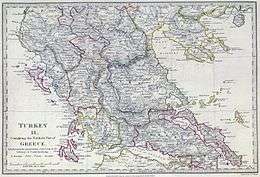Sanjak of Ioannina
| Sanjak of Ioannina | |||||
| Sanjak of the Ottoman Empire | |||||
| |||||
.png) | |||||
| Capital | Ioannina | ||||
| History | |||||
| • | Ottoman capture of Ioannina | 1430 | |||
| • | Battle of Bizani | 1913 | |||
| Today part of | |||||
The Sanjak of Ioannina (variously also Janina or Yanina, Ottoman Turkish: Sanjak-i Yanya) was a sanjak (second-level province) of the Ottoman Empire whose capital was Ioannina in Epirus.
Administration
The Sanjak of Ioannina consisted of the following kazas: the central kaza of Ioannina, Aydonat (modern-day Paramythia in Greece), Filat (modern-day Filiates in Greece), Megva (modern-day Metsovo), Leshovik (modern-day Leskovik in Albania), Konice (modern-day Konitsa), Pogon (modern-day Pogon/Pogoni on the present Greek-Albanian border), and Permedi (modern-day Përmet in Albania).[1][2]

From 1430 to 1670 the sanjak of Janina was part of Rumelia Eyalet.[3] From 1670 to 1787 the Sanjak of Ioannina was part of the Ioannina Eyalet. In 1788 Ali Pasha gained control of Ioannina and merged it with Sanjak of Trikala into the Pashalik of Yanina.[4] Ali Pasha was killed in 1822. In 1834 Mahmood Hamdi pasha was appointed to govern the Sanjak of Delvina, Ioannina and Avlona.[5] In 1867 the Sanjak of Ioannina was merged with Berat, Gjirokastër, Preveza and Kastoria into the Vilayet of Ioannina. Kesriye was later demoted to kaza and bounded to Monastir Vilayet.
During the reign of Bayazid II (1481–1512) the sanjakbey of Ioannina was Dâvud Pasha-zâde Mustafa Bey.[6]
At the elections of 1908 the region elected two representatives for the Ottoman parliament, both of them Greeks: Dimitraki Kingos Efendi and Konstantin Surla Efendi.[7]
The area was occupied by Greek troops during the First Balkan War, and was ceded to Greece in the London peace conference in 1913.
Demography
From 1520 to 1538, according to the Ottoman census, the Sanjak of Ioannina was populated with 32,097 Christian families and 613 Moslem families.[8]
References
- ↑ H. Karpat, Kemal (1985). Ottoman population, 1830-1914: demographic and social characteristics. p. 146. Retrieved 22 September 2011.
- ↑ Motika, Raoul (1995). Türkische Wirtschafts- und Sozialgeschichte (1071-1920). p. 297. Retrieved 22 September 2011.
Sancaks Yanya (Kazas: Yanya, Aydonat (Paramythia), Filat (Philiates), Meçova (Metsovo), Leskovik (war kurzzeitig Sancak) und Koniçe (Konitsa)
- ↑ Haim, Abraham (1991). חברה וקהילה. p. 31. Retrieved 22 September 2011.
large districts and sanjaks in Rumeli: Jannina Naupaktos Egripoz (Euboea) Sanjak of Jannina ...
- ↑ The biographical Dictionary of the Society for the Diffusion of Useful Knowledge, Volume 2, Issue 1. UK. 1843. p. 141. Retrieved 22 September 2011.
To reward his services he was appointed Pasha of Trikala... At the close of the year 1788 he succeeded in obtaining the Sanjak of Janina
- ↑ sir Grenville Temple Temple (10th bart.) (1836). Excursions in the Mediterranean. p. 277. Retrieved 23 July 2013.
Mahmood Hamdi pasha confirmed to the sanjaks of Yanina, Delvina, and Avlonia
- ↑ Prilozi za Orijentalnu Filologiju. 1962. p. 339. Retrieved 20 September 2011.
Poznato nam je da je u doba Bajazita II njen sandžak-beg bio Davudpašazade Mustafa-beg
- ↑ Öztürk, Kâzım (1997). Türk parlamento tarihi : TBMM - III. dönem, 1927 - 1931. Ankara: Türkiye Büyük Millet Meclisi Vakfı. ISBN 978-975-7291-00-8.
- ↑ A. Mikropoulos, Tassos (2008). Elevating and Safeguarding Culture Using Tools of the Information Society. Ioannina: University of Ioannina. p. 310. ISBN 978-960-233-187-3. Retrieved 20 September 2011.
Further reading
- Birken, Andreas (1976). Die Provinzen des Osmanischen Reiches. Beihefte zum Tübinger Atlas des Vorderen Orients (in German). 13. Reichert. ISBN 9783920153568.
- Nikolaidou, Eleftheria I. (1987). "Η οργάνωση του κράτους στην απελευθερωμένη Ήπειρο (1913-1914)" [State organization in liberated Epirus (1913-1914)]. Dodoni (in Greek). Ioannina: History and Archaeology Department of the Philosophical Faculty of the University of Ioannina. 16 (1): 496–610.